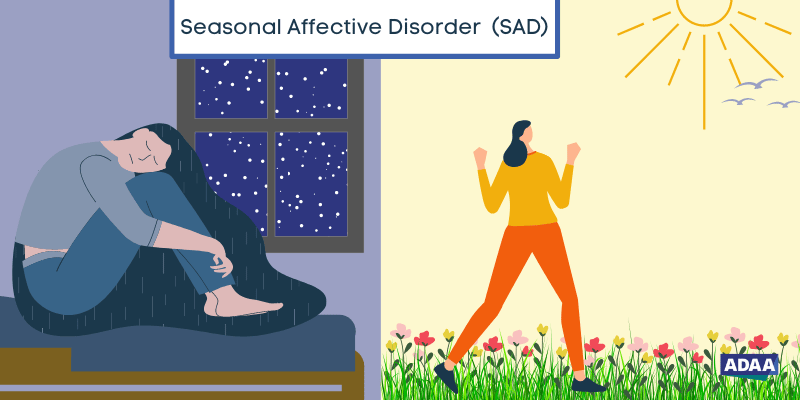Dealing with the Winter Blues: Seasonal Affective Disorder
Winter's shorter days and cold weather can take a toll on your mood and overall well-being. Seasonal affective disorder (SAD) affects many people by causing fatigue, low energy, and feelings of depression. Our latest blog explores how natural light, vitamin D, outdoor activity, good sleep, and a balanced diet can combat these winter blues. Learn how to take small but powerful steps to boost your mental and physical health during the colder months.
Lucas Benson, RN
2/11/20253 min read


The Winter Blues
With the chilly gusts of winter, bringing snow and ice along with the extra steps necessary to combat the elements, our entire conscious attitude can take a negative hit. Prone to the trappings of colder weather and less daylight, humans, while being extremely adaptable to harsh and changing conditions, can feel depleted in the depths of the winter season, even earning its own strikingly appropriate acronym, SAD, or seasonal affective disorder. While SAD is a medical diagnosis, many people complain of symptoms during the winter months that fall under the guise of this mood disorder. The steps experts suggest to avoid or overcome these lowly feelings are basic and simple, almost sounding 'too good to be true’, but nonetheless can have a profound impact on your self-care in the gray sky months.
Creatures Of the Sun
The fundamental element involved in SAD is sunlight. The most obvious change to daily routines during winter is the amount of natural light they are exposed to, thanks to how the earth tilts in relation to the sun. This is easy to overlook as a major cause of mood because the sun's light is always happening, usually delegated to the background while we rush about our lives. But what we may not notice seems to affect us very much. According to the Mayo Clinic, the diminishment of natural light in our daily lives can directly affect a person's wellbeing, whether they are inclined to the outdoors or not.
By prioritizing being outside more during the winter, despite the often uninviting conditions, we can make a dramatic impact on our moods and overall wellbeing. Even cloudy and gray days can give the body some exposure to the natural light of the sun, and mere exposure appears to be the big-gun antidote. In as little as 30 minutes outside we can get enough natural light to keep our heads above the coping line.
To augment or boost one's exposure to natural light, a special lamp or light box may be used to mimic the beneficial exposure. There are many kinds available and may be useful when daytime exposure isn't as possible due to the busy modern schedule.
Vitamin D And Mental Wellbeing
Our bodies are able to produce vitamin D through a synthesis process with the sun, converting the natural rays into the nutrient responsible for many functions within the body, including mental wellbeing. SAD is associated with low levels of vitamin D, so by exposure to the sun (experts say 10-15 minutes per day is often sufficient for vitamin D synthesis) we are giving ourselves a crucial nutrient in our quest to beat the winter blues.
It is possible to also increase our vitamin D levels from the foods we eat. Many fish varieties, such as salmon, contain good levels of vitamin D, as well as eggs and red meat. There are also a number of foods enriched with vitamin D, such as many kinds of cereals and milk. Eating a well-balanced diet, which contains the proper amounts of vitamin D, is one of the bottom line defenses against being unduly affected by the seasonal mood dips.
And, As Always, Exercise and Sleep
The other two hallmarks for frontline defense against seasonal moods are exercise and sleep. By making a point to prioritize using the body, and resting the body, many people are able to not only cope and maintain balance through the winter doldrums but actually find warmth and joy emanating from the added burrs in the saddles of their self-care routines. The effect that even a short morning walk outside can have on a person's state of wellbeing is drastically emphasized in the winter. By combining movement with outdoor time, preferably during daylight hours, you can check off a number of benefits.
The steps work well as a team. If you have eaten a good diet and exercised with some outdoor, natural lighting time, then your ability to get quality sleep at night becomes the warm welcome respite from the opaquely gray landscape it can be. The struggle with not enough daylight exposure ironically gets some reprieve when focus is applied to sleeping at night.
By regulating ourselves into a pattern of enough sleep, followed by a nutritious diet and some outdoor exercise - as simple as a walk in the park - we are able to combat the throes of mood altering weather and cyclical changes to the sun's presence in our lives.
Bottomline For The Winter Blues
The winter season has the ability to adversely affect the human organism, largely felt in negative and depressive attitudes. By recognizing the natural occurrence of these types of mental states we can then focus on how to alleviate them or nip them in the bud before they grow. By giving our self-care focus over to the tasks of braving the outdoor elements, engaging in physical activity and eating a nutritious and well-balanced diet, we can give rise to better sleep and the potential for waking ready to seize the day, even if it's a bit dark and dreary out there. The need for self-care kicks into high gear during the winter, but the steps you can take to help yourself are thankfully rather in reach. The old adage comes to mind, 'He who chops his own wood is warmed twice.'
